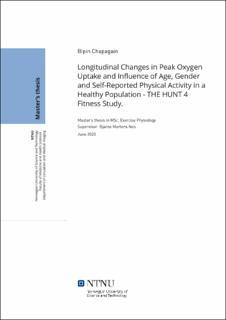| dc.description.abstract | Background: According to a few longitudinal studies, peak oxygen uptake(VO2Peak) declines at a nonlinear rate and accelerates at older ages in both men and women. Rate of decline in VO2peak per decade is higher in men compared to women, and physical activity (PA) reported at high intensity can attenuate the decline in VO2peak. But only a few longitudinal studies had reported the effect of relative intensity and time spend on absolute and percentage decline of VO2peak.
Objectives: The primary aim of the study is to examine the absolute (mL/kg/min) and relative (%) change in VO2peak over 10 years in healthy subjects across different age groups. The secondary aim of the study is to analyze the influence of gender, age, intensity, and level of self-reported PA on change in VO2peak.
Methods: Out of 3264 participants invited from HUNT 3 fitness study (prospective population-based health survey in Nord-Trøndelag, Norway, performed in 2006-08), 1443 participants completed the VO2peak test. 1107 healthy participants (501 men, 606 women) were included in the study. Information on self-reported PA is collected through a questionnaire including questions on duration, frequency, and relative intensity (Borg scale 6-20). Association between PA and the change in VO2peak is assessed through a general linear model.
Results: Longitudinal decline in VO2peak observed across different age groups from <40 years to 70 years shows that the percentage (%) decline of VO2peak is similar in both gender, whereas men show more decline in absolute (mL/kg/min) VO2peak in each decade as compare to women. The relative rate of decline accelerated from 2 to 5 % in the 30s and 40s to > 12% per 10 years in the 70s and beyond. Inactive participants reported a more longitudinal decline in VO2peak than those reported for <75min.wk-1, 75-149 min. wk-1, and 150 min. wk-1. When PA is stratified by intensity and time spend, an absolute decline in VO2peak is lower in participants who reported PA 75-149 min. wk-1 -2 mL/kg/min (95 % confidence interval -0.3 to -0.1)with very vigorous intensity than participants who reported PA 150 min. wk-1 -5.9 mL/kg/min (95% confidence interval -7.1 to -4.7)with moderate intensity. The longitudinal decline in VO2peak did not differ considerably between participants who reported PA at a very vigorous intensity with a duration of less than 75 min. wk-1 and participants who reported PA at moderate intensity with recommended volume.
Conclusions: Our findings conclude that the absolute longitudinal decline of VO2peak is not constant across the age groups, it declines at a nonlinear rate and accelerates after 50 years of age, especially in men and regardless of any PA. The percentage decline of VO2peak is similar between men and women. PA at a moderate intensity of long duration and higher intensity with shorter duration was associated with similar longitudinal declines of VO2peak. Thus, the PA at vigorous and very vigorous intensity helps to attenuate the decline of VO2peak with considerably lower exercise time.
Keywords: Physical activity, VO2peak, PA recommendations. | |
